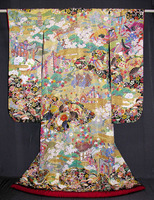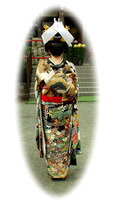

Total:131items
- Pottery & Porcelain (18)
- Lacquerware (4)
- Glasswork (2)
- Wood & Bamboo Work (19)
- Leather Work (1)
- Papermaking (13)
- Textile (20)
- Dyeing products (5)
- Masonry (1)
- Metal Work (11)
- Stationery (4)
- Livingware (3)
- Accessory (4)
- Toys & Entertainment (14)
- Interior (2)
- Other crafts (10)

 |
Main Production Site:Tokyo |
 《Characteristics》
《Characteristics》Edo-Yuzen is also called Tokyo Tegaki Yuzen (Tokyo Hand-painted Yuzen; Yuzen is one of dyeing techniques using rice glue as resist paste) or Tokyo Yuzen (Tokyo was formerly called Edo). It is said that they need to train for as long as 10 years to learn each procedure of Yuzen dyeing.
Edo-Yuzen is influenced by iki (swankiness) and wabi (beauty of simplicity) of people's culture in Edo period (17-19c). Artisans with techniques learned by long training and sophisticated taste dye them by hand-drawing.
Main patterns of Edo-Yuzen are landscapes such as pine trees on beach, fishing boats, fishing net, plovers and reeds. Also, ones that maids in the Edo castle liked are called goten-hu (Edo castle style). It is different from gosho-hu (Imperial Palace style) of Kyoto, decorated with Yusoku patterns (patterns used by noble clans) and gosho-guruma (ox-drawn carriages). Later, the patterns of goten-hu have been passed down as Edotoki pattern (Edotoki: literally Edo disassembling; it comes from the kimonos with goten-hu patterns worn by feudal lords' vassals or Edo castle maids, which were disassembled when sold for townspeople)
Contrary to gorgeous Kyo(Kyoto)-Yuzen, the color of Edo-Yuzen is plain and it uses blue and white efficiently in whole. It has a technique of nori-no-shiroagari, in which pattern parts of textile are covered by glue not to be dyed. It tends to use discreet and subdued red as washed and rusted.
Many of collector's items of Edo-Yuzen are Iro-Tomesode (most formal kimono for married women) and Tsukesage (formal kimono), in which the features are exploited and the colors are bright.
[National Designated Traditional Craft (Designated by Minister of Economy, Trade and Industry)]
Information provided by: Mr. Moriaki Terazawa of Nihombashi Sengei
Translation by: Shione Furuta
Picture upper left: All hand-drawn Yuzen Uchikake (formal kimono, it is put on other kimonos like a gown.)
Picture bottom right: Furisode (most formal kimono for unmarried women) for changing costumes in wedding

| Materials | Silk |
|---|---|
| Crafting Processes | 1. Baste
Baste a desired product. 2. Design Draw patterns of design by lines. 3. Itomenori (Putting starch on design) Put starch on the design to prevent colorants from bleeding to the other part of the pattern. 4. Spreading starch Spread the starch on a fabric. 5. Putting color Putting liquid colorant on the pattern inside the starch with small brushes. 6. Steaming Steam the fabric to fix the liquid colorant and color starch. 7. Putting starch before dyeing base color Before dyeing base color, put starch on the parts that should not be dyed to protect them. 8. Spreading starch The same process as the process 4. 9. Dyeing Dye base color of the fabric. Sophisticated skill is needed to use various brushes. 10. Steaming The same process as the process 6. 11. Washing Wash the fabric with water to remove unnecessary starch. 12. Tentering Stretch the fabric with steam as previously arranged. 13. Finishing with gold and pigments Finish by putting pigments on the detailed parts of the pattern and fixing gold and silver leaves partially. 14. Embroidery Do embroidery on the fabric. [The Kinds of Yuzen] Itomenori Yuzen: Draw lines of patterns by starch where not to be dyed then put colorants. Musen Yuzen: Draw patterns directly on fabrics by brushes. Roketsu (Batik) Yuzen: Use different kinds of wax to dye. |
| History | In 1800s, when the cultural center of Japan moved from Kyoto to Edo (Tokyo), the pattern dyeing of Edo was born. At that time, personal painters of Daimyo (federal loads) moved to Edo because of Sankin-Kotai (the system that Daimyo and their family and retainers have to move back and forth between their home and Edo periodically).
It is also said that an artisan of Kyo-Yuzen called over by Keisho-In (the mother of the fifth Shogun Tsunayoshi Tokugawa) invented the pattern dyeing of Edo. The differences between dyeing of East and West depend on those of their sense of beauty and life. They appear as the differences of patterns and colors. |
| Related URL | http://www.tokyoyuzen.com/index.html |
◆Exhibition / Showcase
Shinshu shinmachi Sun Gallery
Address: 2838-1, Hiharanishi, Shinshu-Shinmachi, Nagano-shi, Nagano
Observation and experience are available.
Contact Form
(Japanese Only)
◆Event Information
Events are held on a regular basis.
See the latest information
(Japanese Only)
Assistance needed? For inquiries in English:
JTCO Contact Form
Your inquiries will be forwarded by JTCO in Japanese to the organization you wish to contact.
*Please write the name of craft you wish to ask about.



